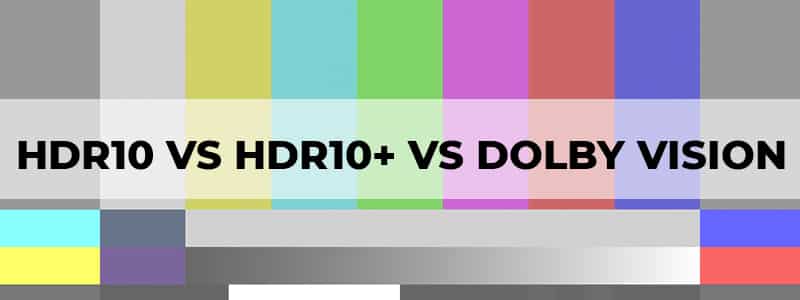
If you’re already aware of what HDR (high-dynamic range) is, you might find yourself with more questions now that you’ve understood the concept.
If you pull out a list of the best 75-80” TVs, you’ll notice that they’re all very evenly split between these three. Ultimately, these are formats of HDR, and each has its relative merits. This article compares the three formats with each other in terms of certain key features.
HDR vs HDR10
It might seem that the best 4K TVs are split between HDR10 and Dolby Vision, whereas some of the best OLEDs are observed to mostly work with HDR10+ all around.
HDR gives a much wider range of much more rich color as compared to SDR, Standard Dynamic Range.
The same can be said for the availability of deeper contrast values, and both of these come together to create a way more realistic picture on our HD, UHD and 4K television sets as compared to older, bulkier and more “traditional” ones, with more liveliness in the image.
One more special feature in HDR TVs is the presence of the highest nit levels, where brightness levels are dimmed and adjusted dynamically for the optimum level of brightness.
HDR10, then, sends static metadata to the video stream – this is information sent directly to the TV that color calibrates it automatically to bring greater realistic clarity to the picture.
Ultimately, HDR10 is the most basic and widely applied HDR format. However, without a 10-bit panel, there is no HDR10. OLED TVs stand out in their regard with their ability to display the deepest blacks, but the technology is rapidly evolving.
It should also be noted that a wide color gamut is not guaranteed by HDR10 – in fact, it is the other way around: without the wide color gamut, the HDR vs HDR10 discussion is moot since your TV will convert the signal to SDR to display it.
HDR10 vs HDR10+
HDR10+ takes the ingenuity of HDR10 and sends dynamic metadata in the stead of static metadata.
This allows the color calibration to happen frame-by-frame both on the level of color and brightness. In terms of nit levels, HDR10+ can produce up to 4000 nits of peak brightness, as opposed to the once-impressive 1000 nits that HDR10 can support.
Both of these also support 10-bit color depth (which translates to roughly 1024 shades of the primary RGB colors). However, the dynamic metadata element is the real winner in this age of streaming, especially since the development was specifically geared at enhancing Samsung TVs and streaming content on Amazon.
But as technology gets upgraded compatibility issues also arise. This means that there are limitations to TV support and content availability when it comes to HDR10+. While a few HDR10+ movies have been released on UHD they are not yet supported by most external playback devices, that is if the TV itself supports them in the first place.
HDR10 also wins out when it comes to streaming on phones, as HDR on phones is mainly limited to streaming services, most of which have not gone beyond HDR10. So, in terms of devices, only high-end Samsung phones such as S10, S10e and S10+ and no gaming consoles or monitors support HDR10+. It all comes down to whether you want the superior bit depth, peak brightness and dynamic metadata enough to wait for the world to catch up to the HDR10+ technology.
In some cases, you can think of HDR10+ as a sort of royalty-free open Dolby Vision (with no additional licensing fees for hardware and content!). However, the comparison with Dolby Vision goes much deeper, as we explain in the next section.
Dolby Vision Vs HDR 10
Dolby Vision is a proprietary standard, made by Dolby, for applying HDR technology. It ramps up the color depth to a whopping 4096 shades, meaning 12-bit color depth, and is geared towards 10,000 nits of peak brightness – essentially being a cinema technology that is being replicated in high-end television sets for the ones that want the best and the latest.
With Dolby Vision you can get the dynamic metadata that comes with HDR10+ with even better bit depth and brightness peak. Device compatibility for Dolby Vision also seems to be growing at a faster rate than the HDR10+, though it is not as universally applicable as HDR10 yet. Most external devices support Dolby Vision but it lags in the amount of DV supporting movies available on disc.
While Samsung remains attached to HDR10+ but Dolby Vision is supported by most Sony, LG, Hisense and TCL models, as well as a few gaming consoles and laptops. At the end of the day the results that come from a wider color gamut and maximum nits of peak brightness depend on the quality of the TV itself. Since HDR is an open-source format, results can vary from manufacturer to manufacturer on different TVs but for the proprietary Dolby Vision format manufacturers have to pay a licensing fee and adhere to a set standard.
Conclusion
Although HDR10+ is highly technically advanced, and Dolby Vision even more so, the lack of content holds them back. Something can be said about the significance of growing Dolby Vision content but HDR10+ content is severely lacking, especially in the US. HDR10 definitely has more content available and is supported by the majority of devices but the technical advantages are not there.
